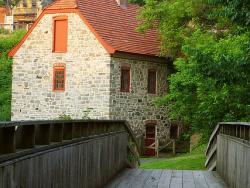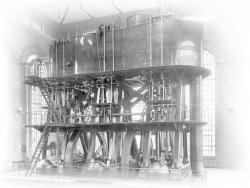Constructed to provide a safe, potable water supply for the citizens of Chicago, Ellis Chesbrough's Chicago Water Supply System was the first major system to utilize offshore intake systems. The system includes the landmark Chicago Water Tower and the Chicago Avenue Pumping Station. Its subaqueous tunnel was a pioneering effort in American civil engineering.
Pumping

Smaller and cheaper than a triple-expansion vertical engine, the horizontal cross-compound pumping engine, Pump No. 2, ran at relatively slow revolutions and was considered the height of engineering from the 1890s to World War I. This pumping engine at the York Water Company was built by the Worthington Pump & Machinery Corporation, Snow-Holly Works, Buffalo, New York.

At the site of the first water pumping station providing water and sewage systems to the City of Erie in 1868, the Chestnut Street Pumping Station houses one of the largest steam engines, which pumped 20 million gallons a day. The triple-expansion steam reciprocating engine, which pumped water from the filter plant to the city reservoir, was typical of those used in municipal water pumping stations throughout the country during the late nineteenth and early twentieth centuries.

The first known pumping system providing drinking and wash water in the North American colonies. The building (still standing) is dated 1761, but it was preceded by an experimental frame building dated 1754. Before the Bethlehem built its system, assigned carriers would daily haul water up the hill from a well near the city gate. A wooden waterwheel, driven by the flow of Monocacy Creek, drove wooden pumps which lifted the water through wooden pipes to the top of the hill where the water was distributed by gravity.

The first known pumping system providing drinking and wash water in the North American colonies. The building (still standing) is dated 1761, but it was preceded by an experimental frame building dated 1754. Before the Bethlehem built its system, assigned carriers would daily haul water up the…
Read More
At the site of the first water pumping station providing water and sewage systems to the City of Erie in 1868, the Chestnut Street Pumping Station houses one of the largest steam engines, which pumped 20 million gallons a day. The triple-expansion steam reciprocating engine, which pumped water…
Read MoreSmaller and cheaper than a triple-expansion vertical engine, the horizontal cross-compound pumping engine, Pump No. 2, ran at relatively slow revolutions and was considered the height of engineering from the 1890s to World War I. This pumping engine at the York Water Company was built by the…
Read More
Constructed to provide a safe, potable water supply for the citizens of Chicago, Ellis Chesbrough's Chicago Water Supply System was the first major system to utilize offshore intake systems. The system includes the landmark Chicago Water Tower and the Chicago Avenue Pumping Station. Its…
Read More

